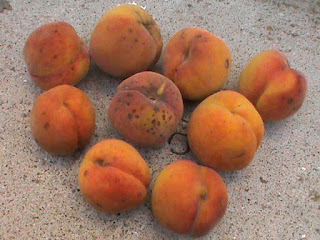We do not grow fruit trees for the market, almost 100% are eaten fresh.
Na foto: Frutos de Outubro recém-apanhados, pêra, dióspiro, medronhos, framboesas, figos, uvas, castanhas, nozes, e tortulhos/cogumelos.
Pear, kaki, arbutus berry, raspberry, figs, grapes, chestnut, walnut and mushroms.
Many of them (rasberries, cherries, peach peels, Arbutus unedo berry, chestnut) are used to give flavour to our home made spirit, and produce a sweet liqueur.
Many trees are located in the gardening anually tilled area (terraces) where vegetables and legumes are grown as annual crops. Some trees are grown in soils that are not being tilled anymore, kept for goat pasture or forage . Almost all trees are watered during the summer (once every 1 or 2 weeks).
The grapes were harvested last saturday (early-mid October) by family and relatives (for making wine), but we kept some of the sweetest ones on the vines for whenever we happen to walk them by ...
Many times, for some people, fruit is the only thing they eat earlier in the morning, and they pick it direclty from the trees.
Peaches, our new young tree fruit is only now slowly turning ripe.
Apples are plenty for all meals everyday, and for the goats. Some of them will be stored and last, be eaten, through the winter.
Pears, our tree has a "overloaded" generous yield, goats have been eating the ones not ripe that have been falling for the last few weeks.
Chest nut, Castanea sativa, we got the first handful today. We have one tree, more than 200 years old(partly colapsing, and a young one growing already inside it), that we care for just about 2 hours per year, cutting ferns and bramble underneath the canopy, and get a harvest of about 50-100 kilos per year.
Walnuts, we will be collecting them soon, we have been hand cleaning the ground from litter dry biomass from herbaceous plants and brambles that grow every year under and on the edge of the canopy.
Raspberries, they are offering us a second yield, now that we had some rain and we can water them more.
Figs, 4 different kinds and in different microclimates, plenty. Some trees started, a few years ago, by cuttings are now giving their first dozens.
Persimons, the goats have been eating the falling ones that turn ripe after a few days off the tree.
Planted a few months ago, this Opuntia yields its first fruit.
Blackberries, wild, almost everywhere, they were sweeter before the rain ... quite a few were used to make liqueur.
Next fruit, to ripe later in the year, are persimons, tangerines and kiwis. Arbutus berries harvest is starting now and will last through December, and olives will be harvested later in December too.
Kiwis, nearly ripe:
Arbutus unedo berries ripening from October until December.
We will be eating a lot of tangerines through the winter and we will be waiting for the loquat, cherries, apricots, raspberries, muleberries and plums again.
To be continued (with more pictures).






















